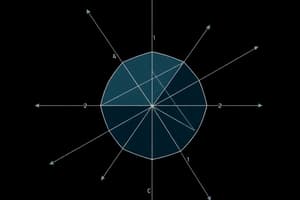Podcast
Questions and Answers
What is the purpose of a coordinate system in two-dimensional analytic geometry?
What is the purpose of a coordinate system in two-dimensional analytic geometry?
- To assign random values to x and y coordinates
- To confuse students with complex grid patterns
- To add unnecessary complexity to mathematical calculations
- To help locate data points on a plane (correct)
How are coordinates typically represented in a two-dimensional coordinate system?
How are coordinates typically represented in a two-dimensional coordinate system?
- By using y-values along the horizontal axis
- By using z-values along the vertical axis
- By using x-values along the vertical axis
- By using x-values along the horizontal axis (correct)
In which quadrant of the coordinate plane would a point with positive x-value and negative y-value lie?
In which quadrant of the coordinate plane would a point with positive x-value and negative y-value lie?
- Third quadrant
- Fourth quadrant
- First quadrant
- Second quadrant (correct)
What does analytic geometry allow us to work with in two dimensions?
What does analytic geometry allow us to work with in two dimensions?
Which pair of numbers defines the location of any point on a two-dimensional plane?
Which pair of numbers defines the location of any point on a two-dimensional plane?
If a point is 3 units to the right and 4 units up from the origin, what are its coordinates?
If a point is 3 units to the right and 4 units up from the origin, what are its coordinates?
What do equations for lines and planes in two-dimensional analytic geometry relate?
What do equations for lines and planes in two-dimensional analytic geometry relate?
How do mathematicians use equations in two-dimensional analytic geometry to make predictions about points?
How do mathematicians use equations in two-dimensional analytic geometry to make predictions about points?
What makes understanding basic principles like coordinate systems and equation representation important in two-dimensional analytic geometry?
What makes understanding basic principles like coordinate systems and equation representation important in two-dimensional analytic geometry?
In two-dimensional analytic geometry, what can linear algebra tools help achieve when applied within a mathematical framework?
In two-dimensional analytic geometry, what can linear algebra tools help achieve when applied within a mathematical framework?
What does two-dimensional analytic geometry provide powerful methods for in terms of visualizing information?
What does two-dimensional analytic geometry provide powerful methods for in terms of visualizing information?
Why might analytic geometry seem intimidating to some due to its variables and equations?
Why might analytic geometry seem intimidating to some due to its variables and equations?
Flashcards are hidden until you start studying
Study Notes
Math is often seen as an abstract subject, full of formulas and symbols that can seem daunting to those who don't study it regularly. However, one aspect of math that you may encounter day-to-day life without even realizing it is two-dimensional geometric analysis. This branch of mathematics deals with understanding space — specifically, how objects relate to each other within it. Here we will explore some key concepts related to two-dimensional analytic geometry so you have a better sense of what this type of math entails.
Coordinate Systems in Analytic Geometry
The first thing you need when working with two-dimensional geometry is a coordinate system – essentially, a grid over which your data points will lie. In most cases, these coordinates are represented by x-values along the horizontal axis and y-values down the vertical axis. With these axes set up, any point on the graph has its own unique pair of numbers that define where it lies on the plane. For example, if we plot a right triangle onto our graph paper, using the center of the page as our origin point (where both x and y equal zero), we would put one vertex at (5,-2) since it's five units across from the origin and minus two below. Once you understand these basics, you are well on your way towards mastering much more complex problems involving analytic geometry.
Working with Lines and Planes
Analytic geometry also allows us to work with lines and planes in two dimensions just like we did before with points. A line has an equation that relates all possible x values to their corresponding y values; similarly, a plane has such equations relating every combination of x/y pairs to z values too. These relationships allow mathematicians to make predictions about what points fall into certain categories based solely upon their position relative to these surfaces.
For instance, let's say you wanted to know whether an imaginary object fell outside of another imaginary object - you could find out by plugging in different sets of numbers into their respective equations until they matched up! Once again here we see how powerful tools like linear algebra become when applied within this type of mathematical framework.
In conclusion, while analytic geometry might seem intimidating due to its many variables and equations at times, understanding basic principles like coordinate systems and equation representation makes solving seemingly complicated problems manageable. From calculating distances between points to making predictions based off shapes formed by sets of numbers, two-dimensional analytic geometry provides powerful methods for visualizing information in ways otherwise unavailable through simple numerical calculations alone.
Studying That Suits You
Use AI to generate personalized quizzes and flashcards to suit your learning preferences.




